Pictorial Glimpses 31-43
Pictorial Glimpses into the Life of Satguru Kabir Saheb
Pictorial Glimpses into the Life of Satguru Kabir Saheb
 When Kabir Saheb returned to Varanasi from Bandhogarh, the devotees were waiting for him. People welcomed him with a grand procession and led him to Kabir Chaura. Satsang and devotional discourses started again with great enthusiasm. King Vir Singh Baghel of Varanasi, along with his queen, attended the satsangs and discourses every day. Gradually, the royal couple became very interested in Satguru Kabir’s spiritual teachings. One day the King invited him to his royal palace. When Satguru went, the queen washed his feet and wiped them. She sprinkled that water all around in the palace. The king and the queen washed the Satguru’s feet again and, with great devotion, they drank that pious water which is called charanamrit (the nectar from the lotus feet). The royal couple garlanded Satguru and offered fragrant flowers. They did Arati (devotional waving of light) and offered various kinds of fruits. After that traditional offering, the king requested that Satguru bless them with spiritual knowledge. Satguru was very pleased with them. He initiated them on the divine path of Sahaj Yoga (Easy Union). He taught them the path of spiritual realization. He showed them the way to practice Surati Shabda Yoga. Thus the royal couple was blessed to their satisfaction.
When Kabir Saheb returned to Varanasi from Bandhogarh, the devotees were waiting for him. People welcomed him with a grand procession and led him to Kabir Chaura. Satsang and devotional discourses started again with great enthusiasm. King Vir Singh Baghel of Varanasi, along with his queen, attended the satsangs and discourses every day. Gradually, the royal couple became very interested in Satguru Kabir’s spiritual teachings. One day the King invited him to his royal palace. When Satguru went, the queen washed his feet and wiped them. She sprinkled that water all around in the palace. The king and the queen washed the Satguru’s feet again and, with great devotion, they drank that pious water which is called charanamrit (the nectar from the lotus feet). The royal couple garlanded Satguru and offered fragrant flowers. They did Arati (devotional waving of light) and offered various kinds of fruits. After that traditional offering, the king requested that Satguru bless them with spiritual knowledge. Satguru was very pleased with them. He initiated them on the divine path of Sahaj Yoga (Easy Union). He taught them the path of spiritual realization. He showed them the way to practice Surati Shabda Yoga. Thus the royal couple was blessed to their satisfaction.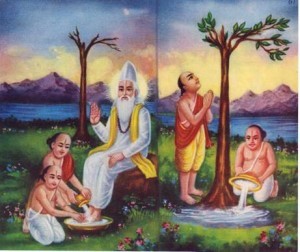 Shuklatirth, a place of pilgrimage, is a village on the bank of the river Narmada, in Gujarat state. There is a small island in the river where two Brahmin brothers, Tatwa and Jeewa, lived a very simple life. They had great respect for sadhus, saints and sanyasis but they lacked peace of mind. A sadhu told them that they would have enlightenment and bliss if a perfect saint initiated them. But it was difficult to find a perfect spiritual master.
Shuklatirth, a place of pilgrimage, is a village on the bank of the river Narmada, in Gujarat state. There is a small island in the river where two Brahmin brothers, Tatwa and Jeewa, lived a very simple life. They had great respect for sadhus, saints and sanyasis but they lacked peace of mind. A sadhu told them that they would have enlightenment and bliss if a perfect saint initiated them. But it was difficult to find a perfect spiritual master.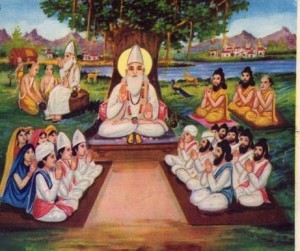 The news about the sprouting of the dry branch of the banyan tree spread rapidly everywhere. Thousands of people went there to see it and to listen to Kabir Saheb’s discourses. At that time Gyaniji Maharaj, the disciple of Khojiji Maharaj, came to see Kabir Saheb. He had thousands of disciples in that area. Gyaniji decided to become Kabir Saheb’s disciple. He told all his followers that whoever wanted to follow him should come and follow the path of Kabir Saheb. All his followers went with him and accepted Kabir Saheb as their guru. Kabir Saheb showered his grace upon them and gave them Divine Knowledge. Gyaniji, by the grace of Satguru, had the realization of the Supreme Lord in his heart. He went to Satguru Kabir and asked him: “O master! We are devotees of Ram and you also preached about the same Supreme Spiritual Being, Chetan Ram. Now I realized that Ram and Kabir are one. I want to make a word of greeting by using both names together. From that time, all the disciples of Gyaniji Maharaj started to use the word: “Ram Kabir.” Ram Kabir Sampradaya (religious sect) thus came into existence. The followers of this sect are in Gujarat, and even outside of India. A large number are in the U. S.
The news about the sprouting of the dry branch of the banyan tree spread rapidly everywhere. Thousands of people went there to see it and to listen to Kabir Saheb’s discourses. At that time Gyaniji Maharaj, the disciple of Khojiji Maharaj, came to see Kabir Saheb. He had thousands of disciples in that area. Gyaniji decided to become Kabir Saheb’s disciple. He told all his followers that whoever wanted to follow him should come and follow the path of Kabir Saheb. All his followers went with him and accepted Kabir Saheb as their guru. Kabir Saheb showered his grace upon them and gave them Divine Knowledge. Gyaniji, by the grace of Satguru, had the realization of the Supreme Lord in his heart. He went to Satguru Kabir and asked him: “O master! We are devotees of Ram and you also preached about the same Supreme Spiritual Being, Chetan Ram. Now I realized that Ram and Kabir are one. I want to make a word of greeting by using both names together. From that time, all the disciples of Gyaniji Maharaj started to use the word: “Ram Kabir.” Ram Kabir Sampradaya (religious sect) thus came into existence. The followers of this sect are in Gujarat, and even outside of India. A large number are in the U. S.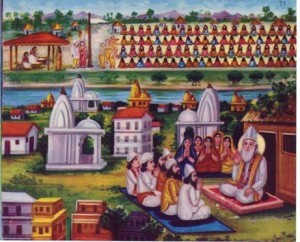 Once Lord Vishnu told Lakshmi that her Maya could not trap Kabir. She said: “No one can escape from my trap. “Lakshmi then went to Kabir Saheb’s ashram and tried to delude him, but he recognized her and told her to return to her abode. Lakshmi realized that she could not trap him and requested that he ask for a boon. He refused; but when she insisted, he told her that, at the right time, he would call on her. Lakshmi, being satisfied, returned to her abode.
Once Lord Vishnu told Lakshmi that her Maya could not trap Kabir. She said: “No one can escape from my trap. “Lakshmi then went to Kabir Saheb’s ashram and tried to delude him, but he recognized her and told her to return to her abode. Lakshmi realized that she could not trap him and requested that he ask for a boon. He refused; but when she insisted, he told her that, at the right time, he would call on her. Lakshmi, being satisfied, returned to her abode.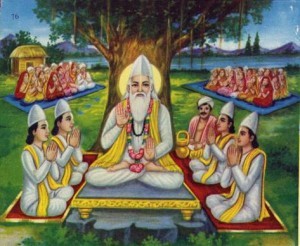 Many disciples of Kabir Saheb used to write his teachings. Some of his philosophical teachings were collected in a book called: “Bijak”. Bijak means the key for spiritual realization. The followers of Kabir Saheb accepted the Bijak as their principal source of knowledge. In this book Kabir Saheb explained about creation and devotion. The major teaching in this book is mystical. Without proper guidance, it is difficult for most people to understand it. The message of Kabir Saheb, in the Bijak, is for the betterment of humanity. Kabir Saheb spoke the plain Truth. He explained about Gyan Yoga (spiritual realization). He taught of the great human qualities and how to obtain contentment and enlightenment.
Many disciples of Kabir Saheb used to write his teachings. Some of his philosophical teachings were collected in a book called: “Bijak”. Bijak means the key for spiritual realization. The followers of Kabir Saheb accepted the Bijak as their principal source of knowledge. In this book Kabir Saheb explained about creation and devotion. The major teaching in this book is mystical. Without proper guidance, it is difficult for most people to understand it. The message of Kabir Saheb, in the Bijak, is for the betterment of humanity. Kabir Saheb spoke the plain Truth. He explained about Gyan Yoga (spiritual realization). He taught of the great human qualities and how to obtain contentment and enlightenment.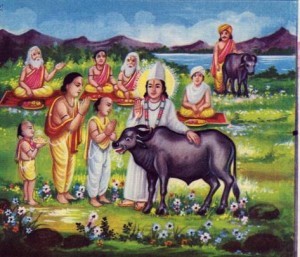 Satguru Kabir Saheb never agreed with the caste system. Many disciples of Swami Ramanand were of low caste. Once Swami Ramanandji was invited to attend a function at Totadri, a place in South India, where the majority of the followers of Ramanuja Vaishnava sect lived. They adhered strictly to the caste system. When Swami Ramanand’s disciples arrived with their belongings loaded on a buffalo, the main priest was confused because the disciples were of various castes. His problem was how to feed them without humiliating his guests. After a discussion with other priests, he declared that only those who could recite the Vedic verses would be allowed to eat with the Brahmins. The others would have to eat elsewhere. Satguru Kabir Saheb did not like that decision and taught them a lesson. He told the head priest that the recitation of the Vedic verses is not difficult even for the buffalo. He told one of his disciples to bring the buffalo. Kabir Saheb told the buffalo: “Please recite some verses of the Vedas.” The buffalo immediately started reciting verses from the Vedas. All the Brahmins were astonished with Kabir’s superhuman power. They were more embarrassed when Kabir Saheb told them to allow the buffalo to sit with them. They realized their folly and, with due respect, bowed down to Kabir Saheb and asked for his forgiveness. Consequently, all the sadhus and saints were allowed to eat together.
Satguru Kabir Saheb never agreed with the caste system. Many disciples of Swami Ramanand were of low caste. Once Swami Ramanandji was invited to attend a function at Totadri, a place in South India, where the majority of the followers of Ramanuja Vaishnava sect lived. They adhered strictly to the caste system. When Swami Ramanand’s disciples arrived with their belongings loaded on a buffalo, the main priest was confused because the disciples were of various castes. His problem was how to feed them without humiliating his guests. After a discussion with other priests, he declared that only those who could recite the Vedic verses would be allowed to eat with the Brahmins. The others would have to eat elsewhere. Satguru Kabir Saheb did not like that decision and taught them a lesson. He told the head priest that the recitation of the Vedic verses is not difficult even for the buffalo. He told one of his disciples to bring the buffalo. Kabir Saheb told the buffalo: “Please recite some verses of the Vedas.” The buffalo immediately started reciting verses from the Vedas. All the Brahmins were astonished with Kabir’s superhuman power. They were more embarrassed when Kabir Saheb told them to allow the buffalo to sit with them. They realized their folly and, with due respect, bowed down to Kabir Saheb and asked for his forgiveness. Consequently, all the sadhus and saints were allowed to eat together.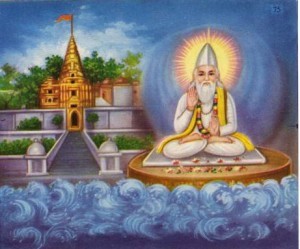 Once Satguru Kabir Saheb was on his tour to preach to the people of Western India. At that time he went to Dwarka, a city of pilgrimage on the seashore in Gujarat. A temple of Lord Krishna is there. When Kabir Saheb stayed in that city, he used to preach to the pilgrims on the sandy beach. His devotional songs influenced the hearts of many. His message of truth, love, devotion and universal brotherhood attracted many people. They became his followers. He taught them not to hurt or kill other creatures. He told them to get rid of the negative passions of lust, anger, attachment, greed and egoism, and to replace them with the noble actions such as to serve, love, give, meditate and realize. On the stone where he used to sit and preach, a rectangular monument was built in his honour. It is called Kabir Kotha. It is said that the tides of the ocean never overflows on that monument.
Once Satguru Kabir Saheb was on his tour to preach to the people of Western India. At that time he went to Dwarka, a city of pilgrimage on the seashore in Gujarat. A temple of Lord Krishna is there. When Kabir Saheb stayed in that city, he used to preach to the pilgrims on the sandy beach. His devotional songs influenced the hearts of many. His message of truth, love, devotion and universal brotherhood attracted many people. They became his followers. He taught them not to hurt or kill other creatures. He told them to get rid of the negative passions of lust, anger, attachment, greed and egoism, and to replace them with the noble actions such as to serve, love, give, meditate and realize. On the stone where he used to sit and preach, a rectangular monument was built in his honour. It is called Kabir Kotha. It is said that the tides of the ocean never overflows on that monument. Once Kabir Saheb told Dharamdasji that in different yugas he appeared with different names. In the Dwapar Yuga, he was called Karunamai (compassionate one). At that time there was a King called Chandravijai who ruled the state of Junagarhh. Indramati was his Queen. She was very devoted. Everyday she used to feed five saints and sadhus before she would eat. She did this for several years. One day she was waiting to feed saints and sadhus, but none came. A few days passed and because of her vow she could not eat. Satguru Kabir Saheb, who was known as Karunamai, heard about this and went to Junagarhh, along with his five disciples. Seeing them, the Queen sent her maidservant to bring them to the palace. However, Swami Karunamai refused to go to the palace. He told the maidservant that the Queen, herself, should come to request their visit. When the Queen heard this, she went personally to invite them. After paying respects to Swami Karunamai, she entreated him to accept the food that she had prepared. His five disciples enjoyed their meal. The Queen felt dejected that Swami Karunamai did not eat. He told her that he did not need to eat. His was the Divine form above the five gross elements. She then requested him to give her some spiritual advice. Swami Karunamai showed her the way of devotion and of easy union with God. He also gave her a glimpse of his Eternal abode. The King and Queen became his disciples. By his grace they reached the Supreme abode.
Once Kabir Saheb told Dharamdasji that in different yugas he appeared with different names. In the Dwapar Yuga, he was called Karunamai (compassionate one). At that time there was a King called Chandravijai who ruled the state of Junagarhh. Indramati was his Queen. She was very devoted. Everyday she used to feed five saints and sadhus before she would eat. She did this for several years. One day she was waiting to feed saints and sadhus, but none came. A few days passed and because of her vow she could not eat. Satguru Kabir Saheb, who was known as Karunamai, heard about this and went to Junagarhh, along with his five disciples. Seeing them, the Queen sent her maidservant to bring them to the palace. However, Swami Karunamai refused to go to the palace. He told the maidservant that the Queen, herself, should come to request their visit. When the Queen heard this, she went personally to invite them. After paying respects to Swami Karunamai, she entreated him to accept the food that she had prepared. His five disciples enjoyed their meal. The Queen felt dejected that Swami Karunamai did not eat. He told her that he did not need to eat. His was the Divine form above the five gross elements. She then requested him to give her some spiritual advice. Swami Karunamai showed her the way of devotion and of easy union with God. He also gave her a glimpse of his Eternal abode. The King and Queen became his disciples. By his grace they reached the Supreme abode.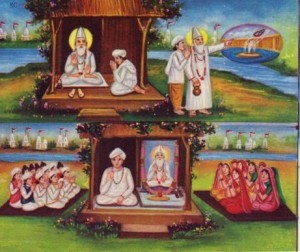 Once Kabir Saheb told the story of his past appearances to Dharamdasji. In Treta Yug Kabir Saheb was famous by the name of Munindra Swami. In Ayodhya, there lived a Brahmin named Madhukar. He was a disciple of Munindra Swami. The first time when Munindra Swami came to Ayodhya, Madhukar went to see him. After listening to his spiritual discourses, Madhukar realized that he was the spiritual master for him. Madhukar bowed at his feet and invited him to his home. He showed a great deal of devotion to Munindra Swami and asked him to accept him as his disciple. Munindra Swami, seeing the earnest desire of Madhukar, accepted him as his disciple. He taught Madhukar the way of Surati Shabda Yoga. Madhukar had the ability to achieve spiritual heights. Munindra Swami taught him the easy union and gave him a glimpse of Satya Purush. Seeing Satya Purush and Satya Lok, Madhukar became very happy. Munindra Swami told Madhukar to preach the Surati Shabda Yoga to others. Many of the people made their way to the Eternal Abode following the path of Surati Shabda Yoga.
Once Kabir Saheb told the story of his past appearances to Dharamdasji. In Treta Yug Kabir Saheb was famous by the name of Munindra Swami. In Ayodhya, there lived a Brahmin named Madhukar. He was a disciple of Munindra Swami. The first time when Munindra Swami came to Ayodhya, Madhukar went to see him. After listening to his spiritual discourses, Madhukar realized that he was the spiritual master for him. Madhukar bowed at his feet and invited him to his home. He showed a great deal of devotion to Munindra Swami and asked him to accept him as his disciple. Munindra Swami, seeing the earnest desire of Madhukar, accepted him as his disciple. He taught Madhukar the way of Surati Shabda Yoga. Madhukar had the ability to achieve spiritual heights. Munindra Swami taught him the easy union and gave him a glimpse of Satya Purush. Seeing Satya Purush and Satya Lok, Madhukar became very happy. Munindra Swami told Madhukar to preach the Surati Shabda Yoga to others. Many of the people made their way to the Eternal Abode following the path of Surati Shabda Yoga.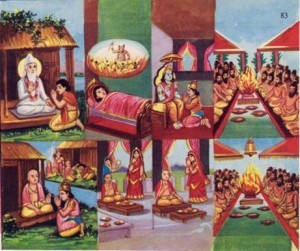 At the end of Dwapar Yug, Kabir Saheb was called Swami Karunamai. He wandered as a saint, preaching the path of Surati Shabda Yoga and devotion. The great war of Mahabharata was over. Many brave kings were killed. Moral values of the people were at low ebb. At that time in Varanasi, there was a devotee of Swami Karunamai named Bhakt Sudarshan who was initiated by Satguru on the path of Surati Shabda Yoga. Bhakt Sudarshan, by the grace of Satguru, became an enlightened soul.
At the end of Dwapar Yug, Kabir Saheb was called Swami Karunamai. He wandered as a saint, preaching the path of Surati Shabda Yoga and devotion. The great war of Mahabharata was over. Many brave kings were killed. Moral values of the people were at low ebb. At that time in Varanasi, there was a devotee of Swami Karunamai named Bhakt Sudarshan who was initiated by Satguru on the path of Surati Shabda Yoga. Bhakt Sudarshan, by the grace of Satguru, became an enlightened soul.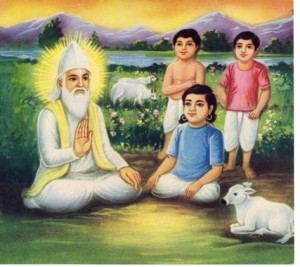 About three hundred years ago Baliram, a farmer, and his wife, devotees of Kabir Saheb, lived at Chhudani, near Delhi. They did meditation, worship and pious deeds. They were happy but they did not have a child. Baliram’s wife earnestly prayed to Satguru for a son, and she got one on the full moon of Vaishakh, in 1774, Vickram era. They named him Garibdas.
About three hundred years ago Baliram, a farmer, and his wife, devotees of Kabir Saheb, lived at Chhudani, near Delhi. They did meditation, worship and pious deeds. They were happy but they did not have a child. Baliram’s wife earnestly prayed to Satguru for a son, and she got one on the full moon of Vaishakh, in 1774, Vickram era. They named him Garibdas.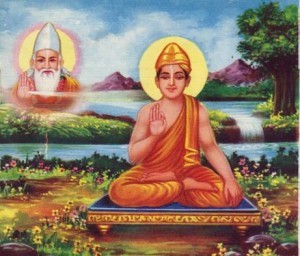 Khekda is a village about 35 Km. from Delhi. A Kaushik Brahmin named Sadasukh lived there with his wife. They were very devoted. Once a follower of Satguru Kabir was their guest. They welcomed him and, with great respect, offered him milk and food. They were impressed with his knowledge, and he initiated them. They then became the follower of Kabir Saheb. From that time they decided to serve food daily to at least one saint or sadhu. The couple continued to offer food to holy men for a long time. Once, for three days, no saint or sadhu went to their home. For the first time the couple felt very sad. They did not eat for those days. Satguru became very pleased with their devotion. After three days, he came to their home as a saint. It made them so happy that they felt that Satguru had appeared before them. Immediately, they served him food with great respect. The saint was very pleased with their devotion. He said to them: “I am very pleased with your hospitality, therefore, I want to give you something in return. Ask for whatever you want.” The couple asked for a child. The saint said that they would have a son. When the son was born he was named Ghisa. Ghisadasji became a saint and acquired many siddhis (accomplishments). Many people accepted Ghisadasji as their guru, and thus Ghisa Panth started.
Khekda is a village about 35 Km. from Delhi. A Kaushik Brahmin named Sadasukh lived there with his wife. They were very devoted. Once a follower of Satguru Kabir was their guest. They welcomed him and, with great respect, offered him milk and food. They were impressed with his knowledge, and he initiated them. They then became the follower of Kabir Saheb. From that time they decided to serve food daily to at least one saint or sadhu. The couple continued to offer food to holy men for a long time. Once, for three days, no saint or sadhu went to their home. For the first time the couple felt very sad. They did not eat for those days. Satguru became very pleased with their devotion. After three days, he came to their home as a saint. It made them so happy that they felt that Satguru had appeared before them. Immediately, they served him food with great respect. The saint was very pleased with their devotion. He said to them: “I am very pleased with your hospitality, therefore, I want to give you something in return. Ask for whatever you want.” The couple asked for a child. The saint said that they would have a son. When the son was born he was named Ghisa. Ghisadasji became a saint and acquired many siddhis (accomplishments). Many people accepted Ghisadasji as their guru, and thus Ghisa Panth started.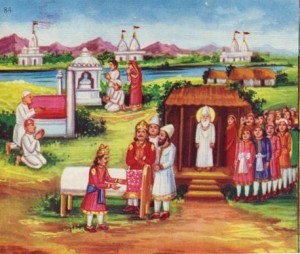 A Pandit from Mithila visited Kabir Saheb at Varanasi and said that who dies at Kashi gets salvation, and who dies at Magahar becomes a donkey in the next incarnation. Kabir Saheb told him that a person gets whatever he deserves. If one does devotion to God he will get salvation anywhere, even in Magahar. The pandit challenged him. In order to prove that all places are equal, Kabir Saheb went to Magahar to die. Thousands of his disciples went there to get his final darshan. Kabir Saheb delivered his last sermon to them. Amongst his followers were Hindus and Muslims. He told them to live in peace and harmony, and not to fight for varying religious beliefs; that his mission was finished and he will be leaving his body shortly. Kabir Saheb then went into the hut and lay down on the floor. The disciples covered him with a sheet and went out. The entire congregation then saw a light disappear in the sky. They knew then that Satguru Kabir had left his body. Hindus said that he was their guru, and wanted to cremate his body. The Muslims said that he was their pir, and wanted to bury him. They forgot the teachings of the last sermon and started to fight. They then heard a Divine Voice: “Stop the fight. Go and see if the body is there.” The important disciples from both Hindus and Muslims went into the hut. When they removed the shroud, they saw only a heap of flowers. They divided the shroud and the flowers equally. Hindus cremated theirs according to their rites, and the Muslims buried theirs. Both of their monuments are still at Magahar.
A Pandit from Mithila visited Kabir Saheb at Varanasi and said that who dies at Kashi gets salvation, and who dies at Magahar becomes a donkey in the next incarnation. Kabir Saheb told him that a person gets whatever he deserves. If one does devotion to God he will get salvation anywhere, even in Magahar. The pandit challenged him. In order to prove that all places are equal, Kabir Saheb went to Magahar to die. Thousands of his disciples went there to get his final darshan. Kabir Saheb delivered his last sermon to them. Amongst his followers were Hindus and Muslims. He told them to live in peace and harmony, and not to fight for varying religious beliefs; that his mission was finished and he will be leaving his body shortly. Kabir Saheb then went into the hut and lay down on the floor. The disciples covered him with a sheet and went out. The entire congregation then saw a light disappear in the sky. They knew then that Satguru Kabir had left his body. Hindus said that he was their guru, and wanted to cremate his body. The Muslims said that he was their pir, and wanted to bury him. They forgot the teachings of the last sermon and started to fight. They then heard a Divine Voice: “Stop the fight. Go and see if the body is there.” The important disciples from both Hindus and Muslims went into the hut. When they removed the shroud, they saw only a heap of flowers. They divided the shroud and the flowers equally. Hindus cremated theirs according to their rites, and the Muslims buried theirs. Both of their monuments are still at Magahar.